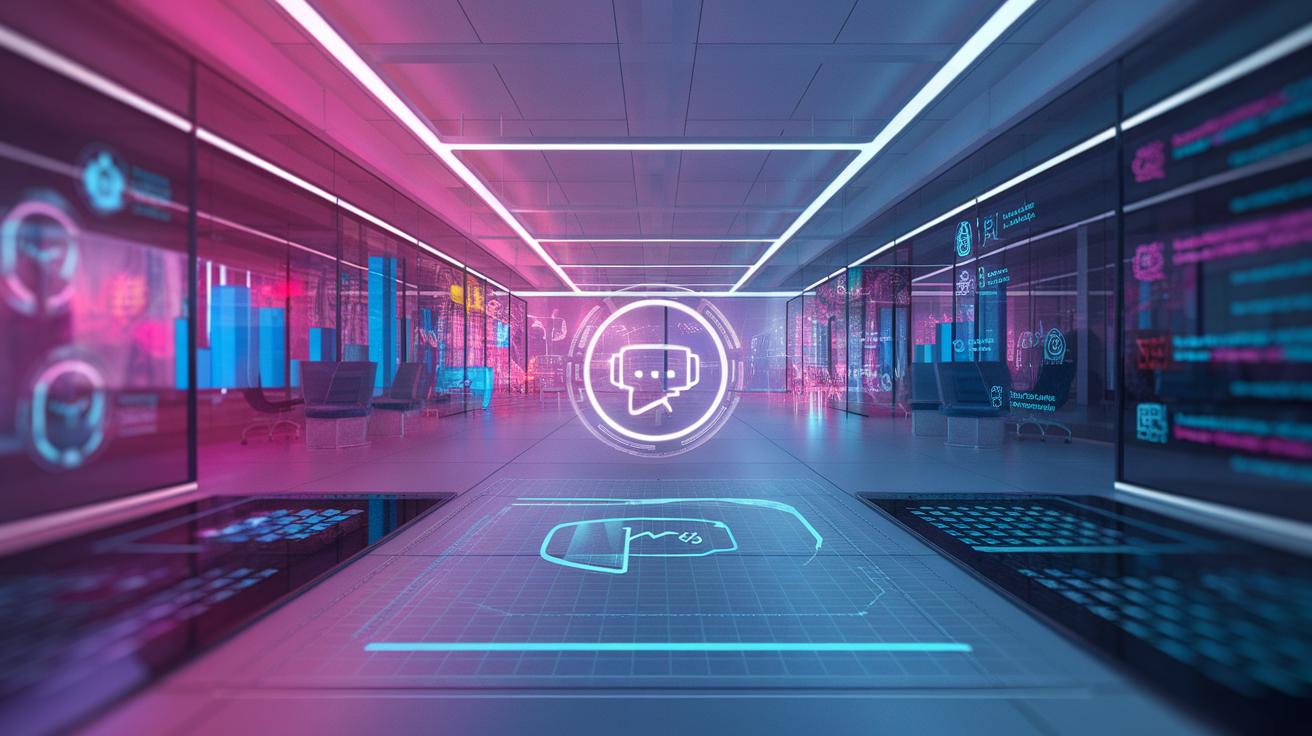Introduction
In recent years, the emergence of Chat AI technologies has revolutionized the way websites enhance user interactions, offering unprecedented opportunities for businesses to engage with their visitors in real-time. By utilizing generative artificial intelligence, platforms are transforming traditional customer support into dynamic, real-time conversations that significantly improve the user experience. The ability of chatbots to understand and process natural language allows for seamless communication, enabling websites to respond promptly and accurately to inquiries, driving user satisfaction and engagement.
This article explores the significant change that Chat AI technology now creates in free website chat experiences. We carefully examine the way chatbots work, the innovative technology that drives them, and the clear benefits they offer for businesses and users. As we study different aspects of Chat AI, you quickly see that this technology proves more than a simple trend; it completely shifts how online communication works and steadily raises user engagement while cutting business costs and boosts customer trust overall.
Understanding Chatbots and Their Functionality
Chatbots, or conversational agents, are software applications designed to simulate human-like interactions through text or voice. They serve as a bridge between users and the vast resources available on websites, facilitating seamless communication. These tools employ artificial intelligence to interpret and respond to user inquiries, providing instant support and guidance. Over the years, chatbots have evolved significantly, transitioning from rudimentary programs that followed simple decision trees to sophisticated systems powered by advanced AI technologies.
The early iterations of chatbots were rule-based, relying on predefined scripts to engage users. They had limited capabilities, often providing generic responses that didn’t account for nuanced user input. With advancements in AI, particularly in natural language processing (NLP), chatbots can now understand context, tone, and even sentiment. This evolution has enhanced their functionality, enabling them to handle a wider range of interactions and provide more personalized experiences. Today’s chatbots can manage simple queries, schedule appointments, and assist with complex customer service issues, all while adapting their responses based on user behavior and feedback.
Modern chatbots leverage machine learning algorithms to improve their responses over time. As they interact with users, they gather data on user preferences, frequently asked questions, and interaction outcomes. This information is analyzed to refine their understanding and enhance future interactions. By continuously learning, chatbots become increasingly adept at predicting user needs and providing relevant solutions. For instance, if a user frequently asks about product specifications, the chatbot can prioritize providing detailed information on similar items in subsequent conversations.
The integration of voice recognition technology allows chatbots to interact through spoken language, broadening their accessibility and ease of use. With the incorporation of AI-driven features such as contextual awareness and predictive text suggestions, these intelligent agents can create conversations that feel more natural and engaging. In essence, chatbots are no longer just basic lines of code; they represent a culmination of technological advancements that can significantly impact user engagement on websites.
The Role of Artificial Intelligence in Chatbots
AI Technologies Enhancing Chatbot Performance
Modern chatbots owe their advanced functionality to the foundational principles of artificial intelligence. The backbone of chatbot technology is powered by two critical AI domains: machine learning (ML) and natural language processing (NLP). These cutting-edge technologies work in concert to elevate user experiences by enabling more fluid and intuitive interactions.
Machine learning allows chatbots to improve their responses based on user interactions over time. Through training data sets, chatbots can recognize patterns in user inquiries and adjust their algorithms accordingly. This continuous learning process equips chatbots with the ability to understand context, making their replies more relevant and personalized. For instance, if a user frequently asks about a specific product, the chatbot will analyze that behavior and prioritize related information in future interactions, enhancing overall engagement.
Natural language processing plays a pivotal role in how chatbots interpret, process, and respond to user queries. NLP breaks down human language into smaller, understandable components, allowing chatbots to grasp nuances such as slang, idioms, and colloquialisms. Advanced NLP techniques enable chatbots to perform sentiment analysis, discerning the emotional tone behind user messages. This understanding aids in crafting appropriate responses, whether a user expresses frustration, satisfaction, or curiosity.
Another significant aspect of AI in chatbots is voice recognition. By implementing speech-to-text technologies, chatbots can cater to voice interactions, offering a convenient way for users to engage without typing. This advancement not only widens accessibility but also aligns with the user preference for hands-free communication, particularly on mobile devices.
Combining AI technologies allows chatbots to handle complex queries much more efficiently. Sophisticated neural networks can support multi-turn dialogues, where users can ask follow-up questions without needing to repeat context. This capability transforms the interaction into a more human-like conversation, significantly enhancing user satisfaction and trust.
As the field of artificial intelligence continues to evolve, the possibilities for enhancing chatbot interaction broaden. Continuous innovations in machine learning and natural language processing will pave the way for even more sophisticated and engaging website interactions, making user support seamless and efficient.
Benefits of Chat AI for Businesses
Cost Reduction and Improved Efficiency
Investing in Chat AI technology presents significant financial advantages for businesses. By automating customer interaction, organizations can significantly reduce the cost associated with staffing large customer service teams. A single Chat AI system can handle thousands of inquiries simultaneously, which eliminates the need for multiple agents during peak hours. This not only leads to direct cost savings on salaries and benefits but also minimizes overhead expenses related to training and maintaining a large workforce.
Chat AI technology streamlines various processes within the organization. With the ability to handle routine inquiries and provide immediate feedback to customers, human agents can focus their efforts on more complex issues that require human empathy and expertise. This enhanced efficiency means that businesses can allocate their resources more effectively, ultimately leading to better productivity and an optimized operational framework.
Enhanced Customer Engagement
One of the most substantial benefits of Chat AI is its capacity to enhance customer engagement. Chat AI systems operate around the clock, providing customers with immediate assistance, regardless of the time of day. This 24/7 availability fosters a sense of convenience and responsiveness, which modern consumers have come to expect. The capability for instant communication leads to higher customer satisfaction levels, thereby creating a loyal customer base.
The interactive nature of Chat AI also allows for personalized conversations. By leveraging user data and prior interactions, these systems can provide tailored responses that resonate with individual preferences and needs. This level of personalization not only improves engagement but also enhances the overall customer experience, as users feel valued and understood.
Businesses can utilize Chat AI to gather valuable insights into customer behavior and preferences through data analytics. These insights can be instrumental for tailoring marketing strategies and product offerings, ultimately leading to a more informed approach to business decisions.
Chat AI technology offers a myriad of advantages for businesses, ranging from cost reductions and operational efficiency to enhanced customer engagement. By integrating these systems, organizations can stay competitive and responsive in an ever-changing market landscape, all while ensuring their customers receive the best possible interaction every time they visit a website.
Challenges and Considerations in Implementing Chat AI Technology
Integration and Compatibility Challenges
Implementing Chat AI technology in a business website can be fraught with challenges, primarily around integration and compatibility. Organizations often utilize multiple platforms for their operations, including CRM systems, content management systems, and other customer engagement tools. The complexity arises when trying to ensure that the Chat AI seamlessly integrates with these existing systems. Complexities can include compatibility with various software versions, data migration issues, and the need for additional development resources to create APIs or connectors that enable smooth interactions. Businesses may find themselves investing significant time and resources to achieve a cohesive environment where the Chat AI operates effectively alongside other systems.
User Experience Considerations
User experience is another critical factor that must be considered when implementing Chat AI technology. While the aim is to enhance user interactions, if the AI does not understand context, users may find themselves frustrated by irrelevant responses. The design of the chat interface also has to cater to a diverse audience with varying levels of tech-savviness. A complex interface can deter users, while a simplistic one might strip away essential features. Ensuring that the Chat AI can handle nuanced queries, maintain conversation context, and provide accurate responses adds layers of complexity to the deployment process. Moreover, capturing user feedback is essential to iteratively improve the experience, which can be a demanding task for many businesses.
Ongoing Maintenance and Updates
Ongoing maintenance and updates present a continuous challenge for businesses that have implemented Chat AI technology. The field of artificial intelligence is continually evolving, necessitating regular updates to the AI’s algorithms and knowledge base to maintain relevance and effectiveness. Organizations may encounter difficulties in allocating appropriate resources for these updates, leading to outdated information and diminished user satisfaction over time. Furthermore, as customer needs and expectations evolve, the Chat AI must adapt accordingly. This could involve retraining the AI with new data sets or integrating new functionalities to meet emerging market trends. Failure to address these ongoing maintenance needs can quickly lead to a decline in user engagement and perceived value.
Future Trends in Chat AI Technology Transforming Website Interactions
Enhancing User Experiences through Advanced Capabilities
Emerging technologies promise to enhance the functionality and versatility of Chat AI, leading to significant transformations in how businesses engage with customers on their websites. One anticipated development is the integration of more sophisticated natural language processing (NLP) capabilities, allowing chatbots to understand context and nuance better than ever before. This evolution will enable bots to engage in more natural and fluid conversations, improving user experiences and promoting brand loyalty.
A rise in emotional intelligence in Chat AI systems is on the horizon. By employing sentiment analysis, these bots will not only detect the user’s emotional state based on text input but also adjust their responses accordingly. This ensures interactions feel more personalized and relevant, addressing users’ needs in real-time. As bots learn from past interactions, they will continue to refine their ability to connect with customers emotionally, fostering deeper engagement.
Integration with Emerging Technologies
In the upcoming years, we can expect substantial advancements in the way Chat AI integrates with other technologies. For instance, combining chatbots with virtual and augmented reality may create immersive customer service experiences. Imagine a scenario where users can visualize products through AR while engaging with a chatbot that provides detailed information and support, making the online shopping experience more interactive and informative.
The use of machine learning algorithms will allow chatbots to analyze interaction data continuously and adapt their strategies based on user behavior. This predictive capability can enhance website interactions by anticipating frequently asked questions or potential issues before they arise, thus allowing companies to streamline customer support efforts effectively.
Another intriguing trend is the rise of multi-agent ecosystems, where different Chat AI bots collaboratively engage with users based on their areas of expertise. For example, a travel website could deploy separate bots specializing in booking, itinerary creation, and local recommendations, creating a seamless and enriched interaction for users. This collaboration can significantly improve response times and the quality of information presented to users.
As businesses continue to explore these advancements, they will likely redefine the nature of customer interactions on websites, paving the way for deeper relationships and improved overall satisfaction.
Case Studies of Successful Chat AI Implementation Transforming Free Website Chat Experiences
Real-World Successes of Chat AI in User Engagement
The practical application of Chat AI technology in website interactions has led to measurable successes across various sectors. Companies are harnessing this innovation to not only enhance user engagement but also improve their customer support systems. A significant example is Domino’s Pizza, which integrated a Chat AI system named “Dom,” allowing customers to place orders via its website or mobile app. Dom’s capability to understand and process natural language queries has streamlined the ordering process, significantly reducing the time spent on each transaction. The result has been a marked increase in online orders and customer satisfaction, with reported engagement rates soaring as a result of this dynamic interface.
Another notable case is that of Sephora, a leading cosmetic retailer. Their Chat AI tool, dubbed “Sephora Virtual Artist,” allows users to interactively engage with the brand through virtual makeup trials on its website. By using augmented reality alongside AI technology, customers can visualize how different products will look on them before making a purchase. This innovative approach has not only driven sales but also fostered a more personalized shopping experience, leading to higher customer retention and increased average order values. The seamless interaction through Chat AI led to an uplift in user engagement by 20%, showcasing the effectiveness of incorporating AI-driven solutions in e-commerce.
Best Practices and Outcomes in Implementing Chat AI
To ensure the success of Chat AI technology in website interactions, organizations must follow best practices. Firstly, companies should focus on providing comprehensive training data for their AI systems, enabling them to understand diverse customer queries accurately. For instance, H&M has successfully utilized Chat AI to address customer service inquiries regarding sizing and availability. By curating a robust dataset based on historical interactions, H&M’s Chat AI system can offer personalized solutions that enhance the overall user experience.
Engagement metrics from various companies reveal that those leveraging Chat AI effectively report higher customer satisfaction scores and reduced response times. Moreover, businesses are seeing significant reductions in operational costs associated with traditional customer support channels. Chat AI solutions not only provide immediate assistance but also gather valuable insights into customer preferences and behaviors, allowing companies to tailor their offerings more strategically. As these case studies illustrate, the integration of Chat AI into web interactions can yield transformative results, reshaping the landscape of customer engagement and support. Overall, embracing this technology paves the way for sustained growth and improved relationships with consumers.
Conclusions
Chat AI technology has significantly reshaped the landscape of online customer interactions, creating a more engaging and efficient platform for both users and businesses. The advancements in natural language processing and generative AI have enabled chatbots to serve as essential tools that enhance user support while streamlining communication processes. As businesses adopt these technologies, they are not only improving user satisfaction but also optimizing their operational workflows.
Looking ahead, the integration of Chat AI into free website chat experiences is set to expand further, presenting new opportunities for innovation in customer service. By embracing this technology, businesses can harness the power of AI to foster more meaningful interactions, paving the way for a future where user engagement is more personalized, responsive, and efficient than ever before. It is clear that Chat AI is here to stay, promising a transformative impact on how we connect and communicate online.
















